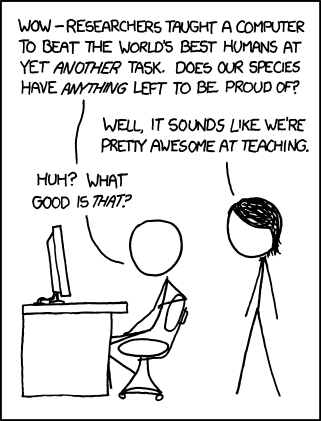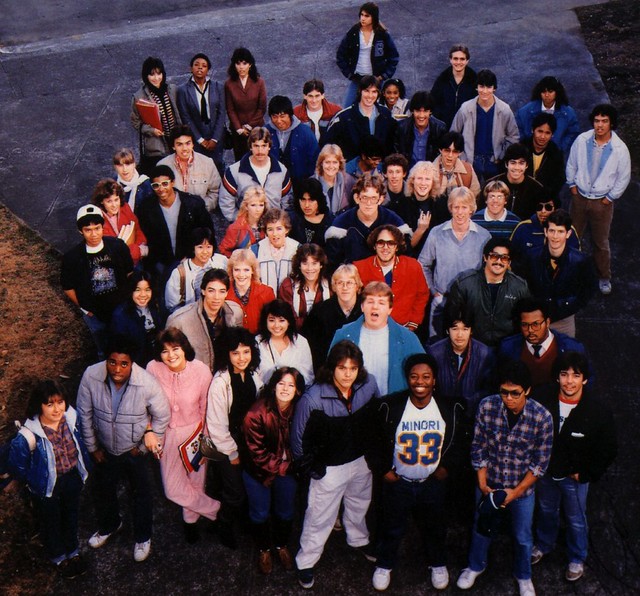 |
John Hocking
From a newspaper article 1981 before a trip to China,
the year before we met. |
|
I attended the memorial of John 'Gib' Hocking this summer, with three of my undergraduate classmates from Michigan State.
Ed Aboufadel, Terry George, and Jim Koss. By accident, my community college calc credit wasn't accepted at MSU, and it was one of the most fortunate accidents of my life. I enrolled in honors math, met people who are my friends to this day, and completely changed my career trajectory. He convinced me to continue on in math, and Ed is the one responsible for me winding up at GVSU.

To say Gib had a fascinating life doesn't do it justice. He went from working at Ford to the University of Michigan, served in army intelligence post-World War II, became an excellent fencer, sailor and race car driver... as well as a respected mathematician. His and Judy's home was famous for its hospitality and at the memorial many testified to the wonders of what they called Three and a Half. He bought the race car in England while on a Fulbright with the proceeds from
his calculus text. (Bought by the publisher so it wouldn't compete with their top seller, said the author.) After retiring from MSU, he worked with a grandson repairing sailboat engines, designed the first new mechanical navigation device in a century, learned how to design heating and cooling systems (and designed them), and became an expert wood worker with the third nicest workshop in the world. (My guess is he knew the probability of meeting 3 people with nicer ones at the same time was effectively nil.) The Topology text he wrote with his advisor Gail Young (cf. the
math genealogy) was the standard for years and is still respected though old-fashioned. (
Dover edition still available!) As a retiree he rewrote large section of a sailing navigation text that had stood for 100 years to simplify and clarify the mathematics.

Ed and I chatted about him this week. Ed recounts how that first semester led him to decide to be a math major. "I want to be a math professor, like that guy." Renaissance man, well-rounded. A mathematician but not just a mathematician. Excellent teacher, Ed tells how he learned a lot about teaching just from being his student. Dr. Hocking really looked at his students and saw what was going on with them. Always made eye contact, and strove to have a sense of where we were. Further, he reached out to us, mentored us. Recommendations, advice, ... personalized our experience at Michigan State which can be rare with 40,000 students. He was a man who was very obviously intelligent but incredibly approachable.
 |
| 4 spartans in Ann Arbor |
We had him for five quarters in a row, and we had no idea how rare that was. He introduced us to topology, like the Alexander horned sphere, Möbius band, and Klein bottle. Shared what problems he was thinking about. Ed notes how he really gave the flavor of what was in store for him as a math student. He taught about the field of mathematics as opposed to just the topic of the day. Always used lots of applications, sailing examples. Ed says he somewhat recently was using the idea of bearings as examples while teaching trigonometry. I'm very grateful to Ed for both inviting him to speak at GVSU a few years ago for our seminar, and for finding out about and organizing our trip to the memorial.
I became a math major because by the time I finished all the stuff that Dr. Hocking had convinced me I needed to take, I was one class away from the degree. The appeal of teaching - based on his teaching - led me to pick the math TA position over the physics lab assistant position. He really formed us into a community. The four of us from the memorial (plus Amy Crammin Shao) were my first experience in a real study group, though we worked with many people from the class over the years. He had the whole class out to his house for Christmas. At the memorial, Bill Sledd, one of his colleagues from MSU (and another influential teacher from my past) remarked on how that group of students sent a remarkable number of people on to grad school.
 |
| Manipulative from Gib's GVSU seminar |
Gib had tricks he'd pull out in the classroom, like a fancy move for drawing an extra large perfect circle, or writing behind his back while facing us. But mostly he was just tremendously authentic, sharing important stories from his life and his genuine thinking about his problems of the moment. We felt like we got to know him. A favorite pet memory of mine is the whole class chipping together to get him a Rubik's cube (expensive in the early 80s) for Christmas. He opens it, turns it this way an that, then says, "Oh," and solves it the first time in a minute. What a lightning quick, fascinating playful mind he had. Several people remarked at the memorial how much he loved games and I love to think what he might have done with games in the classroom.
 |
| Same sparkle at 90. |
So raise a glass and toast to the teacher who inspired you most. Here's to Gib!
Special Thanks: Wendell Hocking, who shared the pictures of Gib for this post. And to the whole Hocking family for letting us share in the memorial.
Appendix: The American Mathematical Society shared the following notice on their "
In Memory Of..."
John G. Hocking (1920-2011)
Hocking, a member of the faculty at Michigan State University from 1951
to 1987, died March 23 at the age of 90. He received his PhD from the
University of Michigan in 1953 under the direction of Gail S. Young.
Hocking and Young wrote a text,
Topology, that was widely used. Hocking was an AMS member since 1951.
Post script: the AMS has finally posted a longer notice, written by Gib's student Som Naimpally.




















